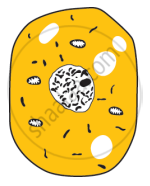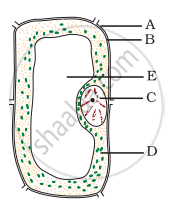Advertisements
Online Mock Tests
Chapters
2: Microorganisms : Friend and Foe
3: Synthetic Fibres and Plastics
4: Materials : Metals and Non-Metals
5: Coal and Petroleum
6: Combustion and Flame
7: Conservation of Plants and Animals
▶ 8: Cell—Structure and Functions
9: Reproduction in Animals
10: Reaching the Age of Adolescence
11: Force
12: Friction
13: Sound
14: Chemical Effects of Electric Current
15: Some Natural Phenomena
16: Light
17: Stars and Solar System
18: Pollution of Air and Water
![NCERT Exemplar solutions for Science [English] Class 8 chapter 8 - Cell—Structure and Functions NCERT Exemplar solutions for Science [English] Class 8 chapter 8 - Cell—Structure and Functions - Shaalaa.com](/images/science-english-class-8_6:5f2b1b2038084cf381bfa42c826a928c.jpg)
Advertisements
Solutions for Chapter 8: Cell—Structure and Functions
Below listed, you can find solutions for Chapter 8 of CBSE NCERT Exemplar for Science [English] Class 8.
NCERT Exemplar solutions for Science [English] Class 8 8 Cell—Structure and Functions Multiple Choice Questions [Pages 40 - 43]
Choose the correct statement with respect to unicellular organisms.
In unicellular organisms, tissues work in coordination to perform different functions
Unicellular organisms do not require food
Unicellular organisms respire and reproduce
AH unicellular organisms move by cilia
Majority of cells cannot be seen directly with our naked eyes because
organisms are generally unicellular
cells are microscopic
cells are present only inside the body
cells are grouped into tissues
Read the different combinations of terms given below :
The correct combination of terms with reference to an animal cell is ______.
Cell wall, cell membrane, nucleus, plastid
Cell wall, nucleus, ribosome, chromosome
Cell membrane, mitochondria, ribosome, chromosome
Cell membrane, ribosome, mitochondria, chloroplast
Which one of the following terms is not a part of the nucleus?
Ribosome
Nucleolus
Chromosome
Gene
A suitable term for the various components of cells is
tissue
cell organelles
chromosomes
genes
The jelly-like substance present in cells is called
protoplasm
chloroplast
chromosome
cytoplasm
Read the following pairs of examples of organisms.
The pair that belongs to the group of prokaryotes is ______.
Moss and sponge
Yeast and Amoeba
Bacteria and blue-green algae
Penicillium and Spirogyra
Read the following terms and select the pair that is related to inheritance of characters.
cell wall and cell membrane
chromosome and mitochondria
chloroplast and cell membrane
chromosome and genes
Choose the correct statements.
Genes are located in the chromosomes
Cell is located in the nucleus
Chromosomes are located in the nucleolus
Cell membrane surrounds the nucleus
Green colour of leaves is due to the presence of the pigment
chlorophyll
mitochondria
ribosomes
chloroplast
The unit of measurement used for expressing dimension (size) of cells is :
centimeter
millimeter
micrometer
meter
The most important function of cell membrane is that it
controls the entry and exit of materials from cell
controls only the entry of materials into cells
controls only the exit of materials into cells
allows entry and exit of materials without any control
Paheli accidentally placed her hand over a flame and immediately pulled it back. She felt the sensation of heat and reacted due to the action of
blood cells
skin surface
nerve cells
nucleus of cells
Of the following parts of a cell name the part that is common to plant cell, animal cell and a bacterial cell.
Chloroplast
Cell wall
Cell membrane
Nucleus
The thread-like structures present in the nucleus are
nucleolus
chromosomes
genes
ribosomes
Identify the statement which is true for cells.
Cells can be easily seen with naked eyes.
Insect’s egg is not a cell.
A single cell can perform all the functions in a unicellular organism.
The size and shape of cells is uniform in multicellular organisms.
Which of the following is not a cell?
Red Blood Corpuscle (RBC)
Bacterium
Spermatozoa
Virus
Which of the following feature will help you in distinguishing a plant cell from an animal cell?
Cell wall
Cell membrane
Mitochondria
Nucleus
Under a microscope Paheli observes a cell that has a cell wall but no distinct nucleus. The cell that she observes is
a plant cell
a nerve cell
an animal cell
a bacterial cell
Cheek cells do not have
cell membrane
golgi apparatus
nucleus
plastids
Identify the correct statement.
Tissue is a group of dissimilar cells
An organ consists of similar cells
Vacuoles are not found in plant cells
Prokaryotes do not have nucleus
Which of the following statements are true for eukaryotic cells?
- They do not have a nuclear membrane.
- They have a well organised nucleus.
- They have a nuclear membrane.
- Blue-green algae are eukaryotic cells.
ii and iv
ii and iii
i and ii
i and iv
Identify the correct statement about cells.
All the cells have nucleus
Cells of an organ have similar structure
Cells of a tissue have similar structure
Shape of all types of cells is round
The table given below has certain terms and four blank spaces named A, B, C and D.
| Cell | Feature/part | Function |
| Amoeba | A | Movement |
| Plant Cell | Plastid | B |
| C | Spindle shaped | Contraction |
| Nerve Cell | D | Stimuli and response |
From the options given below choose the correct combination of terms.
A - Pseudopodia; B - Respiration; C - Muscle cell; D - Branched
A - Pseudopodia; B - Photosynthesis; C - Muscle cell; D - Branched
A - Contractile vacuole; B - Photosynthesis; C - Blood cell; D - Spindle-shaped
A - Pseudopodia; B - Photosynthesis; C - Cheek cell; D - Spindle-shaped
NCERT Exemplar solutions for Science [English] Class 8 8 Cell—Structure and Functions Very Short Answer Questions [Pages 43 - 44]
In leaves name the cell organelle and pigment that is responsible for green colour.
The instrument used to observe cells is ______
We do not sense any pain when we clip our nails or cut our hair. Why?
In a cell, where are the genes located?
Amoeba and Paramecium belong to which category of organisms?
What are the functions of cell wall in plant cells?
NCERT Exemplar solutions for Science [English] Class 8 8 Cell—Structure and Functions Short Answer Questions [Pages 44 - 46]
Is the following statement correct? If it is wrong, correct the statement.
Statement : “Unicellular organisms do not respire, only multicellular organisms respire”
Match the terms given in column I with their functions given in column II and fill the blanks given below the table :
| Column I | Column II |
| A. Chloroplast | i) carries hereditary characters |
| B. Cell membrane | ii) controls the activities of cells |
| C. Nucleus | iii) site of photosynthesis |
| D. Chromosome | iv) controls the movement of materials into and out of cells. |
A - ______ ; B - ______ ; C - ______ ; D - ______
Observe the following figure given below.

Answer the following questions.
- Does it represent a plant cell or an animal cell?
- Does it represent a prokaryotic cell or a eukaryotic cell?
Label the parts A to E in the given figure.

Classify the following terms into cells, tissues and organs and write in the tabular column given below.
| RBC | WBC | Nerve Cell | blood | muscle | blood vessels | brain | heart | hand |
| Cell | Tissue | Organ |
| ______ | ______ | ______ |
| ______ | ______ | ______ |
| ______ | ______ | ______ |
Read the following statement and write the appropriate term against statement.
I control the functions of a cell. Who am I?
Read the following statement and write the appropriate term against statement.
I am like a policeman. I do not allow anything and everything to get in and out of the cell. Who am I?
Read the following statement and write the appropriate term against statement.
I transfer characters from parents to offsprings. Who am I?
Fill in the blanks with the terms given in the box below :
| Nucleus | chromosomes | cell wall | cell membrane | protoplasm | cytoplasm | ribosome | cell organelles |
The outermost layer of plant cells is the __(a)____ beneath which is the __(b)____ The term ___(c)___ refers to the jelly-like substance containing all the ___(d)___ The __(e)____ contains thread-like structures called ___(f)___.
NCERT Exemplar solutions for Science [English] Class 8 8 Cell—Structure and Functions Long Answer Questions [Page 46]
Cells consist of many organelles, yet we do not call any of these organelles as structural and functional unit of living organisms. Explain.
Why do plant cells have an additional layer surrounding the cell membrane? What is the layer known as?
The size of the cells of an organism has no relation with the size of its body. Do you agree? Give reason for your answer.
Solutions for 8: Cell—Structure and Functions
![NCERT Exemplar solutions for Science [English] Class 8 chapter 8 - Cell—Structure and Functions NCERT Exemplar solutions for Science [English] Class 8 chapter 8 - Cell—Structure and Functions - Shaalaa.com](/images/science-english-class-8_6:5f2b1b2038084cf381bfa42c826a928c.jpg)
NCERT Exemplar solutions for Science [English] Class 8 chapter 8 - Cell—Structure and Functions
Shaalaa.com has the CBSE Mathematics Science [English] Class 8 CBSE solutions in a manner that help students grasp basic concepts better and faster. The detailed, step-by-step solutions will help you understand the concepts better and clarify any confusion. NCERT Exemplar solutions for Mathematics Science [English] Class 8 CBSE 8 (Cell—Structure and Functions) include all questions with answers and detailed explanations. This will clear students' doubts about questions and improve their application skills while preparing for board exams.
Further, we at Shaalaa.com provide such solutions so students can prepare for written exams. NCERT Exemplar textbook solutions can be a core help for self-study and provide excellent self-help guidance for students.
Concepts covered in Science [English] Class 8 chapter 8 Cell—Structure and Functions are Cell: Structural and Functional Unit of Life, Structure of the Cell, Plant Cell and Animal Cell, The Invention of the Microscope and the Discovery of Cell, Prokaryotic and Eukaryotic Cell, Organisms Show Variety in Cell Number, Shape and Size, Plasma Membrane, Semi-permeable Membrane (Cell Membrane), Cell Wall - “Supporter and Protector”, Nucleus - “Brain” of the Cell, Cytoplasm - “Area of Movement”, Plastids, Non-living Substances Or Cell Inclusion.
Using NCERT Exemplar Science [English] Class 8 solutions Cell—Structure and Functions exercise by students is an easy way to prepare for the exams, as they involve solutions arranged chapter-wise and also page-wise. The questions involved in NCERT Exemplar Solutions are essential questions that can be asked in the final exam. Maximum CBSE Science [English] Class 8 students prefer NCERT Exemplar Textbook Solutions to score more in exams.
Get the free view of Chapter 8, Cell—Structure and Functions Science [English] Class 8 additional questions for Mathematics Science [English] Class 8 CBSE, and you can use Shaalaa.com to keep it handy for your exam preparation.
